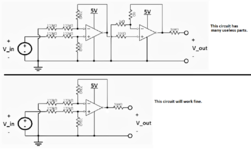hobbskw
Junior Member level 3
Greetings,
I am trying to figure out the overall gain of this circuit analytically. Simulations and experiments both show that it is 0.0832, but how do I go about calculating this by hand? I would greatly appreciate any help!

I am trying to figure out the overall gain of this circuit analytically. Simulations and experiments both show that it is 0.0832, but how do I go about calculating this by hand? I would greatly appreciate any help!
